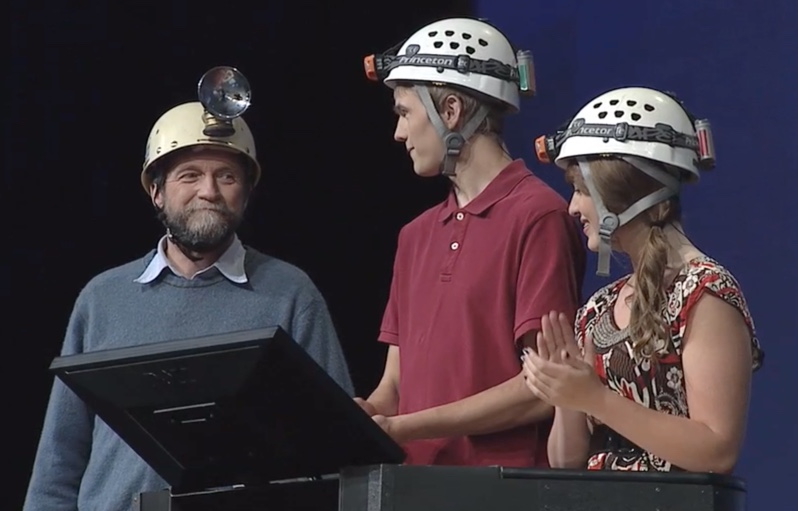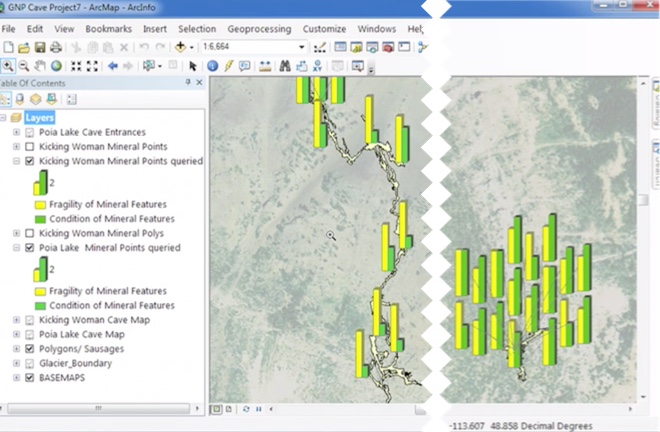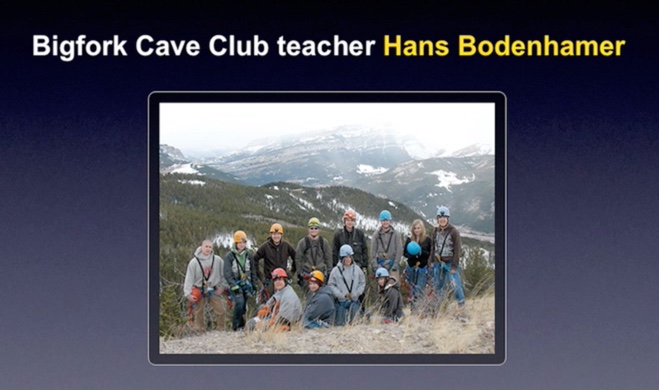- Home
- :
- All Communities
- :
- Industries
- :
- Education
- :
- Education Blog
- :
- Fun with GIS 253: Teaching Underground
Fun with GIS 253: Teaching Underground
- Subscribe to RSS Feed
- Mark as New
- Mark as Read
- Bookmark
- Subscribe
- Printer Friendly Page
- Report Inappropriate Content
[This article has been updated May 2020. See bottom.]
Hans Bodenhamer is an unusual teacher. He doesn't use a cell phone, doesn't spend a ton of time on computers, and engages an "old school" approach to teaching: do projects. And his favorite location for study is distant, dark, dirty, and damp … underground, in caves. If this sounds familiar, you might have seen Esri's 2010 User Conference speakers from the Cave Club of Bigfork High School in Montana.
Bodenhamer used to be a traditional high school science teacher: four sections of biology, one of physics, one of geology. A field trip once included a cave, which led to forming a club, then making maps for local agencies, then doing presentations, then learning about GIS, and then the feedback cycles went organically into overdrive. Students saw GIS in class, did projects, joined cave club, fed passions for the natural world, and wanted to protect it. Local agencies lost employees, needed help, and service projects led to internships and jobs for young people with skills. A local college seeking a pipeline of students collaborated on a dual enrollment class. Cave club regulars earned scholarships, jobs, and experience; alums shared stories, expertise, and inspiration; and public attention grew.
It's not rocket science: engage students in activities that interest them. Seeing a small, confined, unique, and exceedingly fragile natural world, students want to protect it, which requires defining it. "Projects have helped kids feel engaged. It's probably true that Cave Club and GIS have gone hand in hand. Traditionally, we'd use a fiberglass tape, compass, clinometer, and clipboards. Now we use laser instruments to get distance, direction, and angles … but we still use paper. Then we recreate it back at school. And we use a similar approach above ground, like our projects out on lakes. Kids build a sense of a mission, and these local groups have discovered and latched onto that there's a small army of young people who can contribute locally and even wider. Once you get 'em hooked, they will drag you along…"
Along with four sections of 9th grade science (blend of environmental science, ecology, and geology), Bodenhamer now teaches two sections of "Projects in GIS" to students in grades 10-12, many for multiple years. "And because I had some middle school classes for a while, I've taught some kids as many as six years in a row. Students can earn one semester credit at the local college. Most students taking the high school class take the community college credit."
"Cave Club and GIS have directly benefited students in getting great opportunities right out of school. Several received big scholarships. Students in cave club often graduate with over 200 hours of volunteer services and immediately applicable resource management skills (GIS being a big one). Some have received part-time jobs directly out of high school; two years in a row the National Park Service has hired interns directly out of our cave club and the year before a student was given a recreation specialist job with the Forest Service because of her involvement. A couple students have been hired for coveted wildlife technician jobs after high school and while in college as a result of connections they make in Cave Club. Many students who take a GIS class after high school say how easy the college GIS class is. Some end up tutoring other college students. They use specialized skills in our high school class, but just having lots of experience working with GIS makes it easy for them to learn new skills quickly."
There are many good teachers making a tremendous difference to kids, the community, and the planet, with GIS. Their situations vary widely. But they recognize that young people want to be valuable, want to be respected, and want a world worth living in. GIS can help everyone make it happen.
UPDATE May 2020: Once again (as in 2010), Bigfork HS students in the Cave Club have earned the US EPA's US President's Environmental Youth Award, https://www.epa.gov/newsreleases/bigfork-high-school-students-mont-recognized-presidents-environment...
You must be a registered user to add a comment. If you've already registered, sign in. Otherwise, register and sign in.
-
Administration
38 -
Announcements
44 -
Career & Tech Ed
1 -
Curriculum-Learning Resources
178 -
Education Facilities
24 -
Events
47 -
GeoInquiries
1 -
Higher Education
518 -
Informal Education
265 -
Licensing Best Practices
46 -
National Geographic MapMaker
10 -
Pedagogy and Education Theory
187 -
Schools (K - 12)
282 -
Schools (K-12)
184 -
Spatial data
24 -
STEM
3 -
Students - Higher Education
231 -
Students - K-12 Schools
85 -
Success Stories
22 -
TeacherDesk
1 -
Tech Tips
83
- « Previous
- Next »


